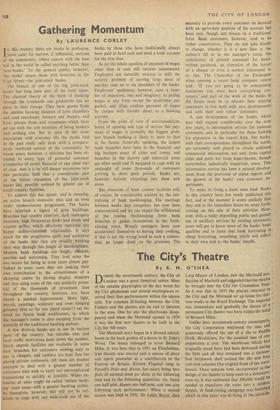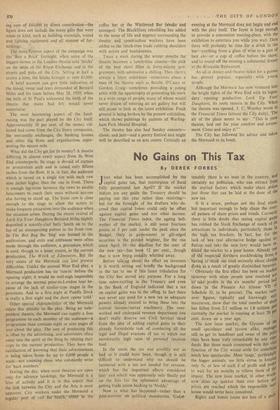The City's Theatre
By K. M. O'SHEA DURING the seventeenth century, the City of London was a great theatrical centre. Most of the notable playwrights of the day wrote for the City playhouses and several masterpieces re- ceived their first performances within the square mile. Yet constant ill-feeling between the City Fathers and the players put an end to theatres in the area. One by one the playhouses disap- peared and when the Mermaid opened in 1959 it was the first new theatre to be built in the City for 300 years.
The Mermaid story began in a disused school- house in the back garden of a house in St. John's Wood. The house belonged to actor Bernard Miles. It was here that in 1951 an Elizabethan- type theatre was erected and a season of plays and opera presented as a contribution to the Festival of Britain. Kirsten Flagstad sang in Purcell's Dido and iEneas, her salary being 'two pints of oatmeal stout per diem, at the following time and in the following quantities, viz. lunch one half-pint, dinner one half-pint, and one pint following each performance.' When a second season was held in 1952, Sir Leslie Boyce, then Lord .Mayor of London, saw the Mermaid pro- duction of Macbeth and suggested that the theatre be brought into the City for Coronation Year. So it was that in 1953 the players returned to the City and the Mermaid set up home for thir- teen weeks in the Royal Exchange. The response was tremendous and' gradually the dream of a permanent City theatre was born within the mind of Bernard Miles.
Unlike their seventeenth-century counterparts, the City Corporation welcomed the idea and generously offered the use of a site at Puddle Dock, Blackfriars, for the nominal rent of one peppercorn a year. The warehouse which had originally stood there had been destroyed during the blitz and all that remained was a thirteen- foot brickwork shell around the site and four cast-iron columns (the original front of the ware- house). These remains were incorporated in the design of the theatre to keep costs to a minimum; even so, it was estimated that £80,000 would be needed to transform the ruins into a modern theatre.. A fund-raising campaign was, launched which in two years was to bring in the astonish-
ing sum of £60,000 by direct contribution—the figure does not include the many gifts that were made in kind, such as building materials, sound and lighting equipment and all manner of fur- nishings.
The most "famous aspect of the campaign was the 'Buy a Brick' fortnight, when some of the biggest names in the London theatre sold 'bricks' on the steps of the Royal Exchange and in the
streets and pubs of the City. Selling at half a crown a time, the bricks brought in over £3,000. A brief account can give little indication of the blood, sweat and tears demanded of Bernard
Miles and his team before May 28, 1959, when the bells of St. Paul's welcomed the birth of the theatre that many had felt would never materialise.
The most heartening aspect of the fund- raising was the part .played by the City itself.
Approximately 38 per cent. of the money col- lected had come from the City livery companies, the mercantile exchanges, the banking houses and other big firms and organisations repre- senting the square mile.
What did the City get for its money? A theatre differing in almost every aspect from its West End counterparts. Its stage is devoid of curtain or proscenium arch and is raised only fifteen inches from the floor. It is, in fact, the audience which is raised on a single tier with each row nine inches higher than the one in front. There is enough leg-room between the rows to enable latecomers to reach their seats without anyone else having to stand up. The front row is close enough to the stage to allow the actors to make frequent excursions into the audience when the occasion arises. During the recent revival of Lock Up Your Daughters Bernard Miles nightly deposited a scantily-clad Sally Smith on to the lap of an unsuspecting patron in the front row. In The Bed Bug the 'bug' was hunted in the auditorium, and exits and entrances were often made through the audience, a procedure which is used, though to a lesser extent, in the current production, The Witch of Edmonton. But the very assets of the Mermaid can also present difficulties. Unlike the normal West End play, a Mermaid production has no 'run-in' before the opening night; it would be well-nigh impossible to arrange the normal prior-to-London tour be- cause of the lack of similar-type stages in the provinces. And so a first night at Puddle Dock is really a first night and the show opens 'cold.'
Other special characteristics' of the Mermaid relate less directly to the play. Being an inde- pendent theatre, the Mermaid can supply a free programme to each member of the audience—a programme than contains eight or nine pages of text about the play. The cost of producing this is offset by the advertising, and advertisers often enter into the spirit of the thing by relating their copy to the current production. They have the satisfaction of knowing that their advertisement is being taken home by up to 6.000 people a week—not counting those who constantly write for 'back numbers.'
During the day, when most theatres are open only for advance bookings, the Mermaid is a hive of activity and it is in this aspect that the link between the City and the Arts is most apparent. City workers make the Mermaid a regular port of call for 'Mach," elthzr in the coffee bar or the Whitbread Bar (steaks and sausages). The Blackfriars rebuilding has added to the sense of life and urgency surrounding the theatre and construction workers have been added to the lunch-time trade rubbing shoulders with actors and businessmen.
Twice a week during the winter months the theatre becomes a lunch-time cinema—the pick of the best short filtns in forty-minute pro- grammes, with admission a shilling. Then there's always a foyer exhibition—sometimes about a man of the theatre such as Brecht, O'Casey or Gordon Craig—sometimes providing a young artist with the opportunity of presenting his work to a wide range of people, many of whom would never dream of entering an art gallery but will still pause to look at tie latest exhibition. Fresh ground is being broken by the present exhibition, which shows paintings by patients of Warling- ham Park Mental Hospital.
The theatre has also had Sunday concerts— classic and jazz—and a poetry festival and might well be described as an arts centre. Certainly an evening at the Mermaid does not begin and end with the play itself. The foyer is large enough to provide a convenient meeting-place, with the exhibition to entertain you while you wait. Then there will probably be time for a drink in the bar—anything from a glass of wine to a pint of best ale—or a cup of coffee before the show; and to round off the evening a substantial dinner at the Riverside Restaurant.
An all-in dinner-and-theatre ticket for a guinea has proved popular, especially with young people.
Although the Mermaid has now ventured into the bright lights of the West End with its legen- dary opening production Lock Up Your Daughters, its roots remain in the City. When the theatre was opened, T. C. Worsley wrote in the Financial Times (almost the City daily), 'The air of the place seems to say: "This is your theatre, laid out for your comfort and amuse- ment. Come and enjoy it."'
The City has followed his advice and taken the Mermaid to its heart.







































 Previous page
Previous page